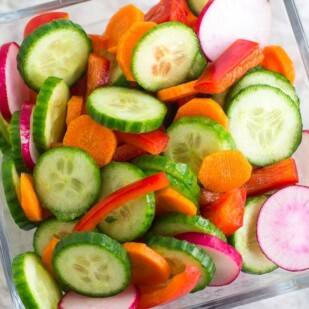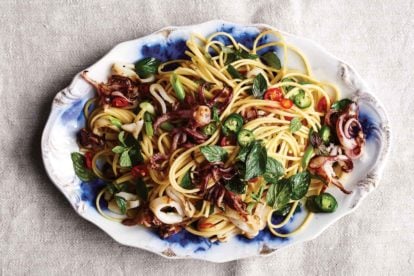A FODMAP IT!™ recipe from
Whole30: Fast and Easy
Note: We received this cookbook from the publisher- but all opinions are our own. This post may include affiliate links. Please see our complete disclosure here.
Warm Salmon and Potato Salad – a Whole30 Compliant Recipe
We get many questions about how the low FODMAP diet intersects with other diets – from gluten-free to raw, paleo to Whole30 and others. This recipe for Warm Salmon and Potato Salad will work for those following a Whole30 diet, as well as a low FODMAP diet.
The only tiny change we made was from using the whole scallions to just scallion greens.
Similarities – and Differences
Both the Whole30 and the low FODMAP diet begin with a month-long phase (or thereabouts) that represents the most restrictive part of the respective diets.
And in each instance, the diet is “re-setting” the body in a way that primes it for a healthier future.
As with all of the recipes that we feature from cookbooks, it is our pleasure to bring to you the world of published recipes that you can include in your low FODMAP lifestyle.
The book Whole30 Fast & Easy has many recipes that are perfect for us FODMAPers such as Blistered Green Beans with Toasted Almonds, Roasted Salmon with Tomatoes and Fennel, Beef and Broccoli Salad and many more.
Whole 30 does not eliminate onions or garlic, so you do have to read through the recipes and make appropriate changes, where necessary.
The book is a compilation of recipes from Whole 30 bloggers and aficionados. This recipe was developed by Brian Kavanaugh of The Sophisticated Caveman blog.
Excerpted from WHOLE30 FAST & EASY © 2017 by Melissa Hartwig. Reproduced by permission of Houghton Mifflin Harcourt. All rights reserved.
From Brian Kavanaugh of The Sophisticated Caveman:
Baby potatoes are tossed in a simple Dijon vinaigrette and served warm. The addition of arugula and salmon makes this a hearty side or even a quick lunch.

FODMAP IT!™ Warm Salmon and Potato Salad
This FODMAP IT!™ Warm Salmon and Potato Salad is Whole30 compliant and works perfectly for us FODMAPers.
Ingredients:
- 1 1/2 pounds (680 g) baby yellow potatoes, halved
- 1/3 cup (75 ml) avocado oil
- 1 tablespoon Dijon mustard
- 1 tablespoon fresh lemon juice
- ½ teaspoon salt
- ½ teaspoon black pepper
- 1 6 ounces/170 g can salmon, drained
- 2 cups (40 g) arugula
- 3 scallions, green parts only, sliced
- 2 tablespoons snipped fresh chives
- 1 tablespoon minced fresh parsley
Preparation:
-
Place the potatoes in a medium pot and add enough cold water to cover. Bring to a low boil and cook until tender, about 15 minutes. Drain.
-
In a large bowl, whisk together the avocado oil, mustard, lemon juice, salt, and pepper. Add the potatoes, salmon, arugula, green onions, chives, and parsley. Gently toss until the potatoes are coated. Serve warm.
Notes:
Tips
- Don't overlook the chives! Chives, which have no detectable FODMAPs, btw, are so often looked upon as an optional add-on. They add color, texture and a singular taste that we love.
Nutrition
All nutritional information is based on third-party calculations and should be considered estimates. Actual nutritional content will vary with brands used, measuring methods, portion sizes and more. For a more detailed explanation, please read our article Understanding The Nutrition Panel Within Our Recipes.











Made this recipe today. You have a really cool blog, but this one was, unfortunately, a dissapointment. Entirely possible one of my ingredients was less-than-ideal, but I found the flavor combination rather unappetizing.
So sorry it wasn’t to your taste! Don’t give up, we have many recipes from which to choose.
Wow! Made this today and loved it!! Not sure about the other review (possibly the ingredients?), but mine turned out great ?
Thank you for letting us know!